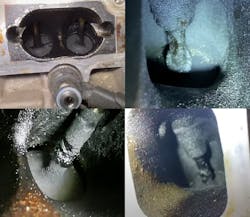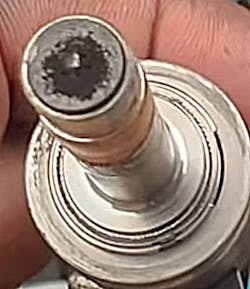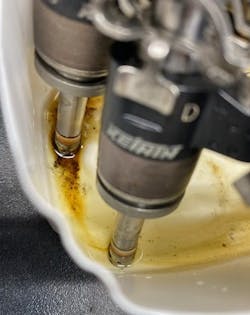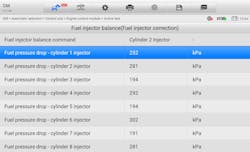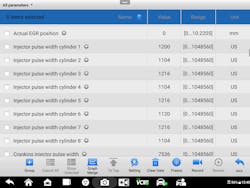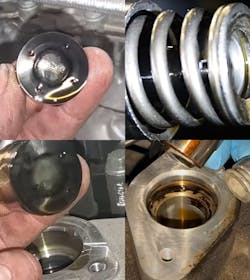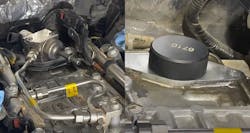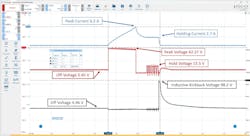In the last 20 years, gasoline direct injection has changed how fuel delivery works in modern engines. GDI improves power, emissions, and economy, but these benefits come with issues. These systems come with a growing list of quirks, service needs, and drivability concerns that we’re seeing more of in the shop.
What makes GDI different?
The basic idea behind GDI isn’t all that complex. GDI systems fire the fuel straight into the combustion chamber, and they do it under some serious pressure. That direct approach gives the PCM a lot more control over when and how much fuel gets delivered, even allowing multiple injection events during a single cycle.
To make that work, a GDI system needs to operate at a much higher pressure than older port systems. Typical GDI rail pressures range from 500 to 3,000 psi (34 to 200 bar) depending on engine load and RPM. Sustaining and dealing with that kind of fuel pressure requires a low-side electric fuel pump, a cam-driven high-pressure fuel pump mechanical pump, pressure sensors, solenoids, control circuits, and a feedback loop. Bosch is now producing HPFP pumps capable of producing over 5,000 psi (350 bar).
GDI injectors require significantly more voltage than traditional port fuel injectors to function due to the higher fuel pressures involved. Instead of 12 volts, they are typically supplied 60 to 70 volts to operate, supplied by internal PCM capacitors (some older BMWs used 200 volts for their piezo injectors).
This is important to remember because standard solenoid lights or test lights won't detect injector drive issues, and diagnosis requires a scope or current probe. Testing GDI injectors requires a different approach than PFI. These systems use a peak-and-hold strategy, where current can spike up to 12 amps to quickly overcome chamber pressure and open the pintle. After opening, the PCM drops the current to around 2.5 to 5 amps to prevent coil overheating while holding the injector open. On the scope, you’ll see a sharp current ramp at injector command, followed by a plateau (hold phase), and a distinct drop when the pintle closes.
GDI systems also demand a different diagnostic mindset. You’re no longer just watching short- and long-term fuel trims. Now you need to be reading high-side versus low-side pressure, injector pulse strategies, pump control duty cycles, and desired versus actual data to confirm system operation. Even with all of that, you may still end up tracing a fault back to something as seemingly unrelated as a sticking PCV valve or a worn timing chain.
The heart of the system: Low and high side fuel delivery
The GDI fuel system has two main sides: low pressure (supply) and high pressure (delivery). On the low side, an electric pump in the tank sends fuel to the high-pressure mechanical pump. It's usually controlled by a fuel pump module or a PCM-integrated driver. Pressure typically ranges from 50 to 80 psi. Some platforms include a low-side pressure sensor. Others don’t, so you’ll need scan tool data, duty cycle, or current ramping to verify operation. Strategies vary: Ford often uses PWM voltage control, while GM, Toyota, and others now use 12-volt three-phase brushless (BLDC) pumps.
On the high side, a cam-driven pump uses a solenoid to regulate pressure and volume in a closed-loop system. The PCM monitors fuel rail pressure and adjusts the solenoid’s duty cycle to match demand. These solenoids are low-resistance (≈ 0.5 ohms) and pulse-controlled around 4,000 Hz. When energized on the pump’s upstroke, pressure rises. A check valve holds pressure when it’s off. Use an amp clamp and scope to verify signal integrity, and remember that amperage only confirms control, not mechanical function.
Always match actual versus desired pressure, and check both low and high sides. Don’t overlook the mechanical pressure relief valve in the pump or rail (it’s a failsafe). If rail pressure drops without a duty cycle change, the relief valve could be weak or stuck. In some VW and Hyundai GDI systems, fuel rail pressure sensors are known to drift over time. If you're seeing erratic pressure readings or codes like P0087/P0088 with no obvious cause, consider a sensor offset issue before replacing pumps or injectors.
If you’re replacing the HPFP, inspect the cam follower and lobes. GM uses a 3-lobe cam; Ford and VW use a 4-lobe cam. Reinstalling a pump on worn components will cause premature failure and pressure issues all over again. Always depressurize the system before disconnecting high-side lines. Even at idle, GDI rail pressure can exceed 500 psi. Always use a torque wrench and follow OEM tightening sequences, as some pumps require angle torque to avoid body distortion.
GDI injection modes
GDI engines switch between several injection modes depending on load and RPM. At light throttle and low speed, many systems run a stratified charge super lean, sometimes up to 40:1, by aiming fuel directly at the spark plug for proper ignition. Under load, the PCM shifts to a more traditional homogeneous mode (14.7:1), with fuel distributed evenly throughout the cylinder.
Cold starts trigger a catalyst heating strategy, where the PCM fires an early injection to start combustion and a secondary shot to heat the light-off catalyst. Some platforms go further, combining an intake-stroke vaporizing spray with a richer compression-stroke shot to ignite leaner air-fuel mixes. This split injection approach is used by Toyota’s Dynamic Force engines, Hyundai Smartstream, Mazda Skyactiv, and GM’s Ecotec Gen III, all of which use dual injection events per cycle. It helps improve combustion efficiency, cut emissions, and reduce NVH, especially during cold starts and low-load cruising. A distorted spray pattern caused by deposits can skew air-fuel mixing, especially in stratified mode, where combustion relies on precise targeting near the spark plug.
All of this is PCM-controlled and varies by OEM, which is why understanding the injection mode matters. A lean fuel trim during cold idle might be by design. A rich condition under light load could be part of a warmup strategy. Without knowing what mode the engine is in, your scan data could lead you down the wrong path.
Injector design, spray patterns, and deposits
GDI injectors are built to handle the heat and pressure inside the combustion chamber, and they’re sealed off with a Teflon ring to keep combustion gases from blowing past the injector tip and causing problems. Newer GDI setups use split injection and multi-hole tips for better combustion. Engines with cylinder deactivation can still see heavy carbon in the shut-down cylinders, especially if they don’t reach temperature on short trips.
Because GDI injectors are exposed directly to combustion, they are prone to heat soak and deposit formation. The issue here is not just soot buildup. The concern involves varnish and waxy olefins that form during hot soak conditions. These deposits can affect spray pattern, droplet size, and overall injector flow rate. What you end up with is usually a random misfire, a stumble when you hit the gas, or a rough start when cold. It might not set a code, but the customer will feel it.
Injector balance tests, especially those using scan tool command or pressure drop measurements, are crucial here. Mode 06 data and power balance readings can help isolate the problem cylinder, but only if the PCM logic is detailed enough to capture it. Don’t assume that fuel system cleaners or additives will clear these deposits. They might, but most modern GDI injector fouling requires mechanical /ultrasonic cleaning or outright replacement.
Fuel dilution: A hidden threat
One of the most serious long-term issues with GDI engines is fuel dilution of the engine oil. Direct injection allows fuel washdown into the crankcase, especially when cold. This raises the oil level, reduces viscosity, and over time, compromises the oil’s ability to protect the engine. Short-trip driving and stop-start systems, which prevent the engine from reaching full operating temperature, can increase carbon deposit formation and contribute to fuel dilution.
Earlier versions of Honda’s 1.5-liter Earth Dreams turbocharged GDI engine (used in CR-V, Civic, and Accord) suffered from this issue, especially in cold climates or with short-trip driving. The engine may not reach full operating temperature, leading to incomplete combustion and fuel washdown. Honda developed a software update to adjust the warm-up strategy and reduce injector-on time during cold starts.
GM and Ford have all issued software updates and procedural recommendations to combat fuel dilution, including extending warm-up times, revising fuel control logic, and recommending more frequent oil changes.
As a technician, one of the first things to check when diagnosing a rich code, rough idle, or PCV-related concern is the oil dipstick. If the oil smells like fuel or is significantly overfull, you may be dealing with an oil dilution problem. And in those cases, changing the oil isn’t just a good idea, it’s essential before continuing the diagnosis.
If you’re chasing a P219A or P219B code (rich imbalance by bank), monitor key-off fuel pressure retention. A bleeding injector or leaking high-pressure pump can be confirmed by how quickly pressure drops after shutoff. Ideally, GDI systems should hold pressure for at least five minutes.
Carbon deposits and Intake valve cleaning
Since GDI injects fuel directly into the chamber, there's no natural cleaning of the intake valves like in port systems. Combine that with leaner combustion, higher compression, and aggressive valve timing, especially in turbo engines, and you’ve got a recipe for carbon buildup. During valve overlap, hot exhaust gases enter the intake tract, carrying soot that sticks to oil from the PCV system. Once it bakes on, it’s there to stay. BMW and VW build up faster, while GM and Ford resist longer, but all eventually misfire cold or set P0300s.
Where carbon forms really matters
Combustion chamber buildup is thin and dense, but valve deposits are soft, thick, and porous, perfect for disrupting airflow and atomization. Even a light coating can cause drivability issues. Engine oil also plays a role not just through PCV vapors, but from additives like friction modifiers designed to protect the HPFP cam follower. These can bake onto hot valves and form stubborn deposits. Carbon in the ring lands restricts movement and reduces compression. Cold soak cleaning can restore 20 to 30 PSI.
To fight this, some OEMs now use dual injection setups combining GDI with port fuel injection. Toyota, Ford, and Hyundai use this to wash the valves at low RPM, then switch to GDI under load. It works well, but not every platform has it.
Carbon chemistry varies by fuel blend, oil type, combustion temp, and drive cycle, so no single cleaner works for all engines. Ethanol-blended fuels (E10/E15) tend to worsen varnish and olefin buildup. While some deposits respond to chemical cleaning, others require walnut blasting. The key is getting the cleaner to the valve. Older methods of spraying ahead of the throttle often fall short as the product pools or sticks just behind the throttle plate. Large droplets pool and miss valves; vacuum methods also fail to atomize. Newer delivery tools atomize the cleaner using an injector-type device after the throttle body, so it can follow the airflow into the ports and attach to the carbon on the valves. Remember, if it doesn’t reach the valve in the proper form, it won’t work, no matter how good the product is.
If you’re chasing cold-start misfires that clear with engine temp, intake valve carbon should be high on your list.
Manufacturer-Specific GDI issues
Ford has recalled a wide range of 2020–2024 SUVs, including Bronco Sport and Escape, for cracked high-pressure injectors. Some allow raw fuel to leak externally, increasing fire risk and triggering check engine lights. Ford’s temporary software patch alerts drivers to pressure loss, but a mechanical fix is still pending. These vehicles share GDI and TGDI hardware with F-150 models, and the symptoms are nearly identical: misfires, lean/rich conditions, and fluctuating fuel pressure. If you're not watching both low- and high-side values in real time, these faults are easy to misread.
The 2024–2025 Ford Ranger with the 2.3-liter TGDI engine isn’t under recall yet, but fuel dilution has become a concern. Oil samples are coming back with 5% or more fuel after only a few thousand miles. The cause appears to be short-trip cycles and poor warmup, allowing fuel washdown. No official TSB exists yet, but the pattern is familiar. Until Ford acts, shops should be checking oil levels and smell during engine complaints, especially if fuel trims or injector balance seem off.
GM issued TSB 20‑NA‑197 after P0191 started showing up on some Silverado and Sierra models, not because of a bad sensor or pump, but due to a poor connection at the fuel rail pressure sensor. Before replacing parts, check the connector for corrosion, clean the terminals, apply dielectric grease, and verify pin tension. If rail pressure looks stable on live data, this simple fix can save time, money, and a misdiagnosis.
Honda’s 1.5-liter turbocharged GDI engines have shown their own set of problems, mostly tied to running excessively rich and cylinder imbalance. Codes like P0172 (system rich), P219E (cylinder imbalance), and random misfires across multiple cylinders are common, usually along with chugging under load or hard starting. Fuel pressure and MAF may look normal, ignition may check out, yet the PCM still sees an imbalance.
The root cause in many of these cases ends up being injector contribution. Honda’s PCM uses cylinder fuel factor testing to measure how much correction each hole needs, and when one or more injectors start over-fueling, those values will fall outside the normal 0.83 to 1.15 range. You can often prove it in the bay by swapping injectors and watching the imbalance follow. That’s why replacing plugs, A/F sensors, or even updating software won’t solve it — the injectors themselves are drifting rich while everything else still looks “in spec.”
The fix is usually new injectors along with a PCM reset and crank relearn. Honda stresses the relearn because accurate crank indexing is critical for misfire detection, and without it, the PCM may keep flagging ghost misfires. Once new injectors are in and the relearn is complete, fuel factor and AF tests settle back into range, and the drivability clears up. The key takeaway: when you’re chasing rich codes and imbalance on Honda’s 1.5-ton, don’t get lost in fuel trim data or sensor swaps — go straight to injector testing, because that’s where the fault often hides.
Hyundai and Kia GDI engines, especially the Theta II 2.0-liter and 2.4-liter, also have a history of fuel dilution under cold-start and short-trip use. Check for fuel odor or rising oil level before digging into drivability concerns. These engines also suffer from intake valve carbon buildup, with misfires and idle issues often appearing around 30,000 miles, even with good maintenance. The newer Smartstream engines are improved, but early imbalance and mild dilution are still showing up in 2.5-liter TGDI models. Whether you're chasing a lean code or a misfire, oil condition, intake valve cleanliness, and injector contribution should all be part of your diagnostic process, even if no codes are set.
Diagnostics: Scopes, scan tools, and safety
Diagnosing GDI problems requires more than just a scanner and a code reader. You need to understand both sides of the system, be able to command components, and, in many cases, verify pressures manually. Always compare desired versus actual high fuel rail pressure and allow stabilization time at idle before recording data. If you're getting a P0191 code (fuel rail pressure sensor performance), be aware that each manufacturer has slightly different criteria for what that code means. For example, GM may log it if desired and actual fuel pressures differ for more than three seconds; Ford uses a 20-psi delta for eight seconds.
High-side fuel pressure testing should also include assessing the HPFP pumps' reserve capacity by commanding it to exceed expected load pressures and watching to see if it can deliver. The HPFP reserve capacity refers to the pump’s ability to exceed fuel pressure demand under load without maxing out its control duty cycle. To check HPFP reserve capacity, technicians should monitor actual fuel rail pressure versus desired fuel rail pressure during a snap throttle or high-load event. If the HPFP can meet or exceed demand without maxing out the duty cycle, it’s got good reserve capacity. But, if pressure lags while the solenoid command is near 100%, the HPFP may be maxed out, failing, or possibly there is a low-side restriction or low-pressure supply pump issue.
Final Thoughts: GDI isn’t going anywhere; it’s in everything from small cars to full-size trucks and hybrids. The systems are getting more advanced, and so are the problems. To diagnose them properly, you need to understand how the whole system works, not just the basics. That means using scope data, checking both sides of the fuel system, and knowing what to look for when symptoms show up. Whether it’s fuel in the oil, a lazy injector, or a random misfire, it comes down to knowing where to start and what to rule out. And with GDI strategies changing through software updates and new hardware, staying current is just as important as knowing how it all works.
About the Author

Jeff Taylor
Jeff Taylor is a seasoned professional at CARS Inc. in Oshawa with 40 years in the automotive industry. As a skilled technical writer and training developer, he holds licenses in both automotive and heavy-duty vehicle repair. Jeff excels in TAC support, technical training, troubleshooting, and shaping the future of automotive expertise.

